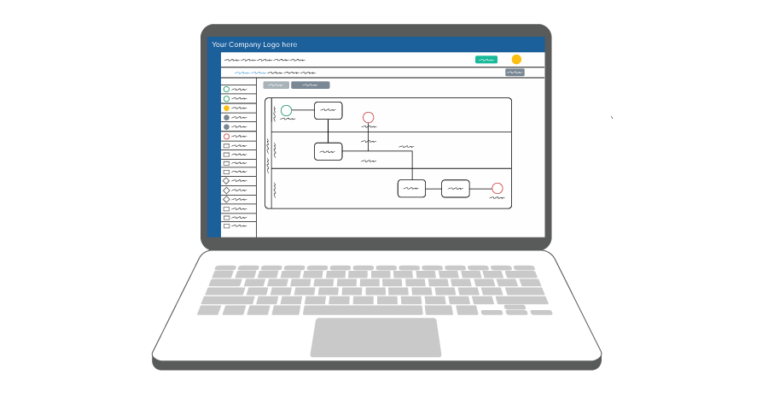Business process management (BPM) is a highly useful strategy to streamline your organization’s workflows. Automating business processes using BPM software can make you more efficient and productive. However, automating your processes with regular BPM platforms can be nigh-impossible without some degree of coding knowledge. To make process automation more accessible to the entire organization, a growing number of companies are adopting low-code BPM software.
What is Low-Code BPM Software?
Even basic functionalities in standard BPM platforms require you to write a few lines of code to test the condition. You also need to add code for purposes such as:
- Sending and retrieving information from a database using queries
- Changing task assignment based on a variable value
- Auto-filling fields on forms
- Making connections to external applications
With low-code BPM software, you can perform these tasks with drag-and-drop elements or built-in features without needing a degree in computer science.
Low-code BPM applications, and other low-code solutions, have enabled the rise of what IT research and advisory firm Gartner calls “citizen developers”: end-users who create software outside of a development team. According to a 2017 survey, three-fourths of organizations report that at least some of their applications are developed by employees other than the IT department.
Regular vs. Low-Code BPM Platforms
Regular software for business process management requires a good deal of coding knowledge to create fully-functional automated processes. For example, most of the Java BPM engines on the market today are “ultra-high-code,” meaning that you need to know Java to deploy automated processes. If you want to customize complex workflows, you’ll either have to hire an external team or build a knowledgeable in-house IT team.
During traditional software development, processes may take months to roll out. Deploying the application is labor-intensive and expensive, and changes need to be hand-coded into the software.
Low-code BPM platforms, on the other hand, provide predefined triggers within “packets” of code. You can change and move these “packets” around on a high-level process map, without directly touching the codebase. Due to the simple nature of the tools offered by low-code BPM platforms, they are ideal for simple processes, such as common administrative processes like Leave of Absence requests or Purchase Orders. The drastic improvement in ease of use means that basic processes can be automated, tested, and deployed in a matter of weeks.
The Benefits of Low-Code BPM Software
Simplicity
Simply put, low-code software is easy to understand and easy to create. Non-technical business analysts and managers can design and control processes, playing a greater role in workflow optimization. Due to this simplicity, low-code BPM software is best-suited for straightforward processes that require little customization.
The lower learning curve for low-code platforms speeds up deployment across the entire enterprise. What’s more, because it’s easier to get software up and running, it’s easier to get buy-ins from management to start automating your workflows.
Flexibility
If you go with a packaged software solution from a vendor, then trying to add new functionality without access to the source code can prove difficult or impossible. Low-code software, on the other hand, allows you to build features on top of the platform, rather than from scratch.
Ready-made connectors allow you to integrate your low-code creations with external applications, forming a powerful software-based workflow. Low-code software is easier to fit in with your existing processes and easier to scale with the size of the company and the duration of the project.
Speed
Low-code development, even in the hands of inexperienced users, is, on the whole, faster than traditional development, making your business more nimble and agile. Build mature, efficient workflows in weeks, rather than the months it would take for traditional development.
As your business needs evolve, you can alter your software immediately, rather than waiting for the vendor to push out a new update. It’s also easier to create a proof of concept for new projects, letting you get buy-in from key decision-makers more quickly.
Cost-Effectiveness
By eliminating the need to hire external partners, low-code platforms let you keep software development in-house. Rather than needing a dedicated budget for software development, low-code platforms spread the costs of development across the salaries of all employees. Even non-IT users can now create the software they need to do their jobs.
The development process is democratized so you can quickly scrap and rework projects as your business objectives change. You can also create multiple specialized solutions for different business niches, without having to purchase pricey software licenses.
The Downsides of Low-Code BPM Platforms
Despite the major advantages of low-code platforms, they’re not always the right solution for every application. For one, building complicated workflows with a low-code platform is not feasible. Low-code platforms limit Java developers who may want to write their own code to customize forms and processes.
Generally, developers are not fans of low-code BPM platforms. Trying to execute complicated business logic, while writing little or no code, inevitably means a sacrifice somewhere along the line. Although catering to business analysts with low-code platforms gains you the advantages above, there are also tradeoffs. Some of the sacrifices include the loss of some flexibility and expressivity during development. The only way to figure out if low-code software is right for you is to try it out for yourself.
Low-code software has a variety of advantages for organizations of all sizes and industries; including BPM ROI. By drastically lowering development time and empowering citizen developers, low-code software makes it easier than ever to pursue the right BPM automation strategy. Find out what a BPM platform can do for your company’s processes with a free trial of ProcessMaker Enterprise.





